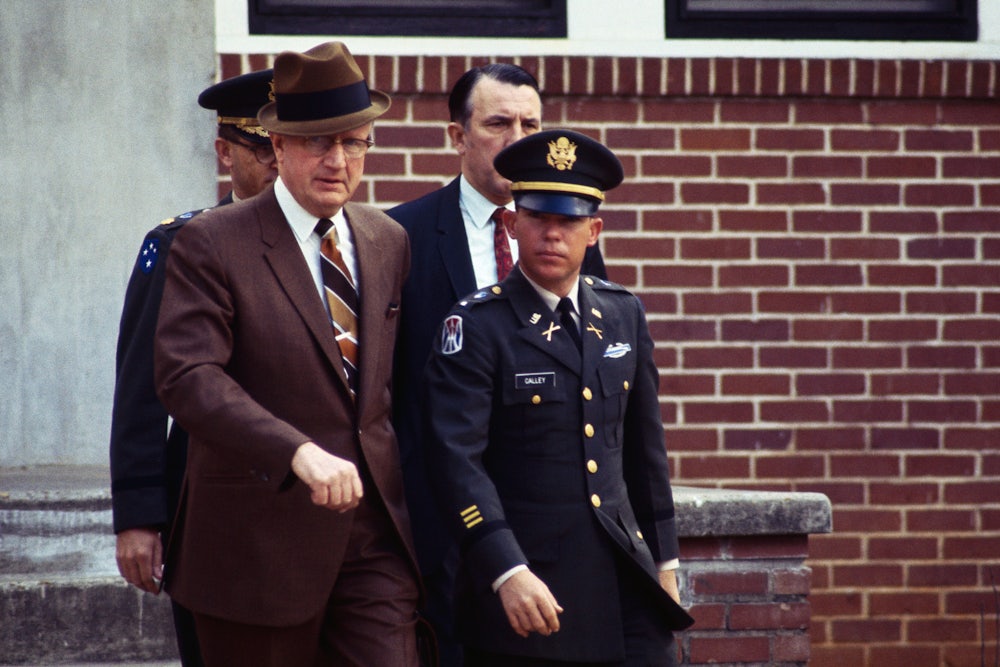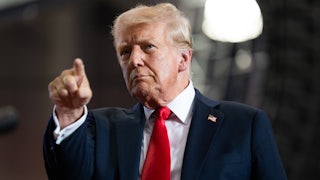Before there was a yawning cultural divide over Donald Trump, there was a yawning cultural divide over William L. Calley, who, The Washington Post revealed this week, died this past April at 80. The Calley Gap and the Trump Gap are different ways of describing the same cultural breach.
Calley divided the country into two groups. The first, broadly but not exclusively working class, pledged support for the former Army lieutenant, who was court-martialed for murdering 504 innocent civilians in South Vietnam. Today this same group pledges fealty to a former president convicted on 34 counts of felony fraud.
The second group, broadly but not exclusively of the professional-managerial class, was repelled by Calley and his supporters. Today this group is similarly repelled by Trump and his supporters.
Let me state before proceeding further that there are two important differences between Calley and Trump. The first is that—even in a combat setting—murder is a much worse offense than criminal fraud. The second difference is that, whereas Trump’s claims to victimhood are 100 percent hooey—the man is a billionaire who committed crimes with impunity, both in and out of office—Calley really was a victim (though hardly an innocent one), in the sense that the Army made him the fall guy for the March 1968 My Lai massacre. In the end, not even Calley’s commanding officer, Captain Ernest Medina, who was present in My Lai, was punished. Higher-ups, meanwhile, never answered for covering up Calley’s crime, which they swept under the rug for more than a year until an Army whistleblower and the investigative reporter Seymour Hersh forced them to act.
The My Lai massacre occurred during the Tet Offensive, a series of attacks in 1968 by the North Vietnamese People’s Army and its guerrilla allies in the south, the Viet Cong. A group of five platoons called Charlie Company suffered heavy losses as it conducted search-and-destroy missions in South Vietnamese villages and hamlets. The difference between who was a civilian and who was Viet Cong was usually unclear. U.S. troops addressed this problem by declaring certain areas “free-fire zones” and distributing leaflets advising civilians to leave the area. But as is true today when Israeli soldiers make similar efforts in Gaza, the civilians often had no place to go.
According to Hersh’s 1970 book, My Lai 4, Calley’s platoon entered that hamlet (subsequently known just as My Lai) with instructions to flush out a Viet Cong battalion of about 260 men. “The idea was to destroy the village,” Medina later said, “so the 48th VC would be forced to move.” Houses, bunkers, and tunnels were ordered destroyed, and livestock ordered killed. According to multiple witnesses quoted by Hersh—Medina and at least one other witness denied this—Medina further ordered the killing of men, women, and children. “The way I think he said it,” recalled one, “and the way they took it—was that anything in the village was VC.”
Calley followed his instructions to the letter, even though he and his men never came under fire. On the lieutenant’s orders, about 80 villagers were taken from their houses and herded into a plaza. Some shouted, “No VC. No VC.” When Calley returned 10 minutes later and found them still alive, he said: “Haven’t you got rid of them yet? I want them dead.” Calley then hoisted his M16 rifle and started shooting them himself. Pretty soon, according to Hersh, “there was shooting everywhere.” Medina saw at least some of this and did nothing to stop it. “I cut their throats, cut off their hands, cut out their tongue, their hair, scalped them,” recalled one participant, who later killed himself. “I did it. A lot of people were doing it, and I just followed.”
The Army issued a press release, written by a witness to the massacre, that portrayed My Lai as a victorious raid on a “Viet Cong stronghold.” One task force commander was quoted saying the operation “went like clockwork.” That would have remained the official story had not an infantryman named Ronald Ridenhour with an investigative bent (he later became a reporter) heard about the massacre. Ridenhour quietly gathered evidence and, on returning to the United States, sent a letter detailing the My Lai massacre to the Pentagon, the State Department, and 24 members of Congress. Ridenhour’s letter led to the equivalent of a grand jury proceeding against Calley.
Even then, the prosecution might well have gone nowhere. But Hersh got wind of the proceeding, tracked down Calley and his accusers, and wrote a Pulitzer Prize–winning newspaper series and, later, two books about My Lai. Without Hersh’s iron will, the story would likely have been contained and Calley acquitted. Eugene L. Fidell, who teaches military law at Yale Law School, told me he could recall no court martials involving this sort of civilian slaughter during World War II and the Korean War.
Getting the press interested in My Lai proved almost as difficult as getting the Army to prosecute. In his 2018 memoir, Reporter, Hersh related that Ridenhour tried to sell a My Lai story to Life, Look, Harper’s, and The Washington Post. None was interested. The same editor at Life turned Hersh down four months later. Robert Silvers wanted to run Hersh’s account in The New York Review of Books, but Hersh (foolishly) balked when Silvers proposed adding a contextual paragraph near the top and decided to syndicate the story himself with the help of the antiwar activist turned literary agent David Obst. The only nationally prominent editor Hersh could persuade to run his first story in the series was Ben Bradlee of The Washington Post. “Goddamn it,” Bradlee said, according to Hersh, “I’ve got hundreds of reporters working for me and this has to come from the outside. Publish it. It smells right.”
The military tribunal found Calley guilty and sentenced him to life (later reduced to 20 years and still later to 10; in the end, Calley served three years, much of it under house arrest through the intercession of President Richard Nixon).* Shaun Raviv, in a 2018 Smithsonian article commemorating My Lai’s fiftieth anniversary, described the public reaction this way:
His name became a rallying cry on both the right and the left. Hawks said that Calley had been simply doing his job. Doves said Calley had taken the fall for the generals and politicians who’d dragged America into a disastrous and immoral conflict.… Indiana Gov. Edgar Whitcomb ordered the state’s flags to fly at half-staff. Gov. John Bell Williams of Mississippi said his state was “about ready to secede from the Union” over the Calley verdict.
George Wallace, the MAGA forerunner who’d run for president the year before, demanded a presidential pardon for Calley and posed with him for a photograph. Raviv continues:
Two musicians from Muscle Shoals, Alabama, released a recording called “The Battle Hymn of Lt. Calley,” which included the line, “There’s no other way to wage a war.” It sold more than a million copies. Digger O’Dell, a professional showman based in Columbus, Georgia, buried himself alive for 79 days in a used-car lot. Passersby could drop a coin into a tube that led down to O’Dell’s “grave,” with the proceeds going toward a fund for Calley. He later welded shut the doors of his car, refusing to come out until Calley was set free.
George McGovern, meanwhile, said that My Lai
took the mask off the Vietnam War.… I think that, for the first time, millions of Americans are realizing that we have stumbled into a conflict where we not only, of necessity, commit atrocities against the people of Vietnam, but where in a sense we brutalize our own people and our own nation.
Esquire somehow persuaded the unwary Calley to pose for a chilling cover photograph in which he was surrounded by Asian children. In the accompanying article, Calley rambled in a manner one might call Trumpian:
People ask me, “What do you have against women and children?” Damn, I haven’t a thing! I love women. I love children, too. I love people. I haven’t a thing against them. But people say, “Why did you kill, then?” Well damn! Why did I go to Vietnam?
Calley elaborated, grotesquely, in a 1971 memoir:
On babies everyone’s really hung up. “But babies! The little, innocent babies!” Of course, we’ve been in Vietnam for 10 years now. If we’re in Vietnam another 10, if your son is killed by those babies, you’ll cry at me, “Why didn’t you kill those babies that day?”
This voice sounds familiar, no? Coarse, morally obtuse, yet inexplicably beloved by a sizable portion of Americans? It’s still with us more than half a century later. Perhaps we should be grateful Calley never ran for president.
Trump did, of course, and acted in a way not even Nixon did in Calley’s case, in 2019 pardoning a pair of Army officers convicted of committing atrocities in Afghanistan and Iraq and promoting a Navy officer acquitted of killing Iraqi civilians and an enemy prisoner—all over the objections of Pentagon leadership. “We train our boys to be killing machines, then prosecute them when they kill!” Trump tweeted. The following year Trump pardoned four Blackwater private security contractors convicted of similar crimes.
Unlike Trump, Calley eventually tired of unfriendly press coverage and withdrew so far from the public eye that after a researcher at Harvard Law School recently stumbled on a record of Calley’s death, his family still declined to confirm it. Calley held a distorted mirror before the country he served—the same mirror Donald Trump brandished in 2016 and 2020, and again this year. A lot of people want to say, “That is not who we are.” In truth, it sometimes is.
* An earlier version of this article misstated the length of Calley’s imprisonment and the role that Nixon played in easing it.








